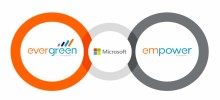Transaction Integration (time and expense)
This feature was introduced to ensure seamless integration of Time and Expense type transactions from Project Operations to Business Central. Transactions which are posted in Project Operations will now synchronise with Business Central through a configured Dataverse Connection setup.
New sections have been added under the BC Integration tab in evergreen parameter to provide details on integration of time and expense transactions.
Transactions Integration Fields and Descriptions
| Field | Description |
|---|---|
| Transactions Integration Period |
Indicates the time within which the integration of transactions takes place from Project Operations to Business Central. It is an editable field where users can choose between Day or Month. |
| Time Transaction |
Time Transactions Flow Triggered On: Display field indicating the date and time of the last integration flow for time transactions triggered from Project Operations to Business Central. Time Transaction Flow Status: Display field indicating the status of time transactions integration flow. Time Transactions Flow Details: Display field indicating details of the time transactions integration flow. |
| Expense Transactions |
Expense Transactions Flow Triggered On: Display field indicating the date and time of the last integration flow for expense transactions triggered from Project Operations to Business Central. Expense Transaction Flow Status: Display field indicating the status of expense transactions integration flow. Expense Transactions Flow Details: Display field indicating details of the expense transactions integration flow. |
evergreen BC Time and Expense staging
Two new forms, SAG BC Time Transactions Line Staging and SAG BC Expense Transactions line staging has been introduced.
Project Operations > Sales > evergreen > SAG BC Time transactions or SAG BC Expense Transactions
When Time or Expense transactions are posted in Project Operations in SAG BC Time Transactions staging and SAG BC expense Transactions are grouped by following criteria:
Date – also dependant on the parameter setup mentioned in the previous chapter
Project
Transaction Category
Billing type
Depending on these four categories Quantity and Amount are grouped and show total Quantity and Amount
Integration in Business Central
Two new tables, “Dataverse Time Entries,” and “Dataverse Expense Entries,” have been introduced in Business Central to streamline the integration of Transactions from Project Operations. This integration ensures seamless synchronization and supports both manual and automatic updates between Project Operations and Business Central.
Users can create General journals from Project Operations directly into Business Central.
Users can select a record in the Dataverse Time entries or Dataverse Expense entries form and manually trigger the “Create in Business Central” button. This action will create general journal lines in Business central.
A “Coupled” field in the Dataverse Time entries table switches to “Yes” upon successful creation of the general journal lines in Business Central.
Transactions (from Navigation Menu)> Time entries > Dataverse Time entries or Dataverse expense entries
Fields and Descriptions
| Field | Description |
|---|---|
| Coupled | A Yes/No field indicating whether data has been created in Business Central (BC) or not. |
| Document Date | Indicates the document creation date. |
| BC Actual Id | Indicates the unique Business Central identifier. |
| BC Posted Actual Id | Shows the General Ledger Entry ID of posted transactions. |
| Transaction Category | Indicates the transaction category. |
| Billing Type | Indicates the billing type. |
| Project Id | Indicates the ID of the project. |
| Quantity | Indicates the quantity. |
| Amount | Indicates the amount. |
Once created in Business Central, time entry Transactions create lines in General Journals from where the user can manually post the transactions. based on the setup in Business Central
_Dashboard > Finance Setup > Project Posting Groups _
Fields and Descriptions
| Field | Description |
|---|---|
| Transaction Category Name |
|
| Transaction Class |
|
| Default |
|









Post your comment on this topic.